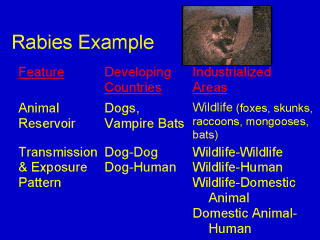|
|
|
|
front |1 |2 |3 |4 |5 |6 |7 |8 |9 |10 |11 |12 |13 |14 |15 |16 |17 |18 |19 |20 |21 |22 |23 |24 |25 |26 |27 |28 |29 |30 |31 |32 |review |
 |
Infectious agent: Rabies virus, a rhabdovirus of the genus Lyssavirus. Occurrence: Worldwide, with an estimated 35,000-40,000 deaths a year, almost all in developing countries. Reservoir: Many wild and domestic Canidae, including dogs, coyotes, wolves and jackals; also skunks, raccoons, mongooses, bats and other biting mammals. Mode of transmission: Virus-laden saliva of a rabid animal is introduced by a bite, scratch, or break in the skin. Incubation period: Usually 3-8 weeks; depends on the severity of the wound, site of the wound, and amount and strain of virus introduced. Methods of control and prevention: Register, license and immunize all dogs in enzootic countries; immunize all cats; maintain active surveillance for rabies in animals. See pages 382-390 in Control of Communicable Diseases Manual for more detailed information.
The epidemiologic features of a zoonotic disease such as rabies may differ depending on geographic, cultural, and socioeconomic conditions since these influence the pattern of human-animal interactions.
|